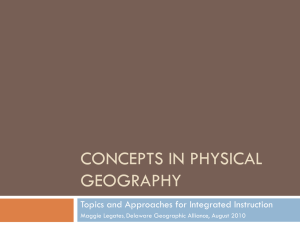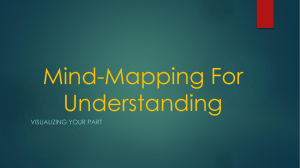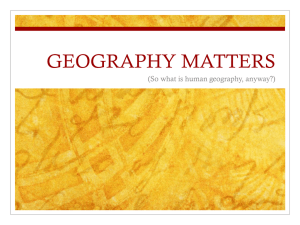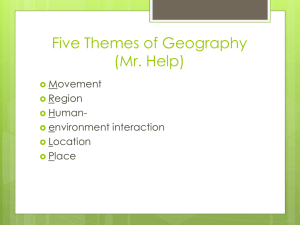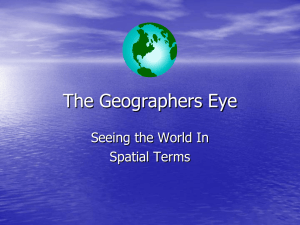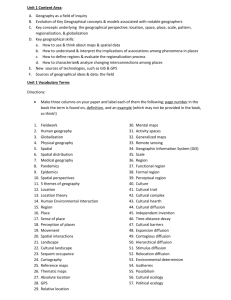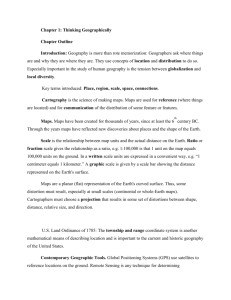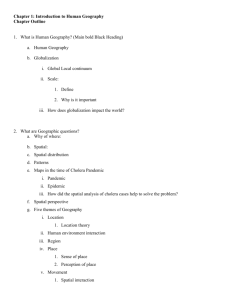Intro to Human Geography
advertisement
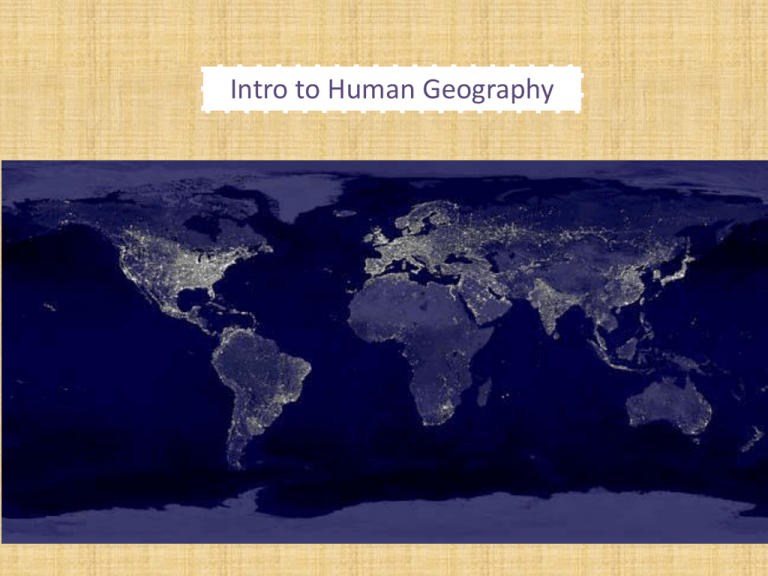
Intro to Human Geography Objectives! • Be able to explain what geography is and why it is relevant. • Identify the difference between physical and human geography. • Identify and explain the basic theories about the relationship between people and their environment. • Understand what culture and cultural ecology is. What is Geography? • Geographers ask where things are and why – it is a spatial science. • We are concerned with globalization and local diversity, and the tension between them. • Complex discipline with a human and physical division. Why is Geography Important? Culture • Two aspects: – What people care about • Beliefs, values, and customs – What people take care of • Earning a living; obtaining food, clothing, and shelter Culture 1. A social creation. 2. It changes! Culture is dynamic. 3. It’s a complex system. We practice our culture through our interactions with others at the same time that we are impacted it. Natural Processes • • • • Climate Vegetation Soil Landforms These four features are important for understanding human activities What’s the Relationship Between People and the Environment? • Cultural Ecology - The geographic study of human–environment relationships 1) Environmental determinism – the environment causes human development • Actor-Network Theory 2) Possibilism – people have the ability to adjust to their environment But Wait, We Change the Earth too.. 3) Humans as Modifiers • Take natural landscapes and turn them into cultural landscapes. English Landscape by Capability Brown The Cultural Landscape • A unique combination of social relationships and physical processes • Carl Sauer • Each region = a distinctive landscape • People = the most important agents of change to Earth’s surface http://www.panoramio.com/map/ Integrated Systems 4) People + Earth = integrated – The Earth is a system that has different parts that interact – Humans and nature cause changes in the operations of the Earth-system Objective • Get familiar with the five key geographic concepts, and start to apply them to real life. Main Concepts • • • • • Place Space Diffusion Spatial Interaction Scale Place: Unique Location of a Feature • Location – Place names • Toponyms – Site – physical characteristics of a place – Situation – location of a place relative to other places & political, economic, social context – Mathematical location (lat and long) A place is a specific point on Earth. Take a moment and jot down a description of a place you are from using the terms site and situation. Map of Washington State Types of Regions – Regional Analysis • Formal (uniform) regions – Examples: voting districts, states (Virginia), English-speaking world, Bread Basket of the US, tropical climate zones • Functional (nodal) regions – Examples: the circulation area of a newspaper, bus service areas, police service area • Perceptual (vernacular) regions – Examples: the American South, Pacific Northwest, everywhere people love the Huskies Formal Regions Functional Regions Television Markets of the U.S. King County Wastewater Service Area Vernacular (Perceptual) Regions Lewis Historical Society • Think back to the place you are from—what regions is your home part of? Spatial Association • Regions are useful because we can use them explore the correlations of events to places. • Regions can encompass an area of widely varying scales, from a small to a large portion. ex., geographers study local politics or international politics. • Depending on the scale of the region, different conclusions may be drawn about a region’s characteristics. Spatial Association • Examples: – Prevalence of HIV/AIDS – Impact of Sandy on 2012 Presidential Election – Relationship of Unemployment to Population Change – Plague in the United States Space • Absolute vs. Relative space • Distribution—three features – Density – frequency with which something occurs in space. – Concentration – a feature’s spread over space. Clustered? Dispersed? – Pattern –arrangement of objects in space. Geometric? Irregular? Spatial Variation • The changes in the distribution of a phenomenon from one place or region to another. Spatial Interaction Refers to the connections that develop between places, for example: transportation & communication. What is globalization? Our text discusses two types of globalization: Economic and cultural Spatial Interaction – Complementarity – when a place can supply what another place needs – Transferability – cost of moving a good and the profitability of moving that good – Intervening Opportunities – when there are places that can supply a good cheaper than other places Spatial Interaction People, ideas, commodities move between places. • Distance decay - Tapering off of a process, pattern or event over a distance. - “Everything is related to everything else, but near things are more related than distant things.” Diffusion • The process by which a characteristic spreads across space and over time---but doesn’t mean it stays the same! • Hearth = place from which an innovation originates • Types of diffusion – Relocation – Expansion • Three types: hierarchical, contagious, stimulus Connections Time Space Convergence – reduction in time it takes for something to reach another place. Globalization doesn’t change actual distance, but it can make places seem closer. Scale Way of depicting the world in a reduced form. Two Kinds: • Cartographic scale : expresses ratio of distance on map to Earth. • Observational / methodological scale – levels of analysis. – Local, regional, national, international scales Where Are You From? • How is the place you are from connected to other places---what is the spatial interaction like? Review • • • • • • • • What is geography? Why is geography relevant? Place: site, situation, mathematical location Regions: types of regions Cultural landscape, culture and cultural ecology Scale Globalization Space – Ways features are distributed and arranged, terms used to describe them • Connections: Spatial interaction, diffusion
